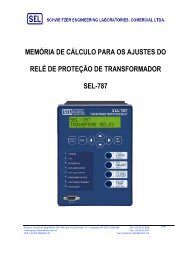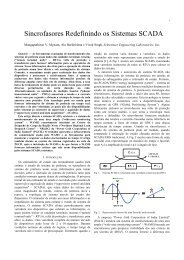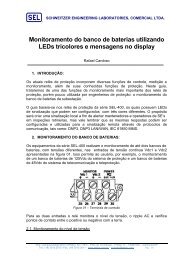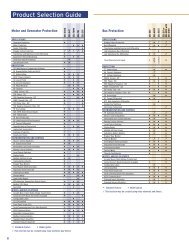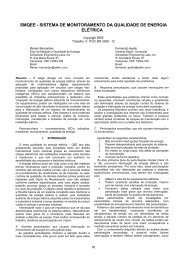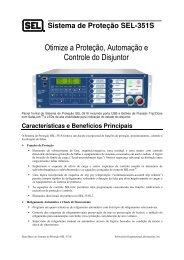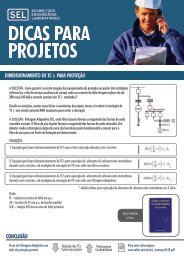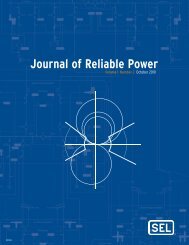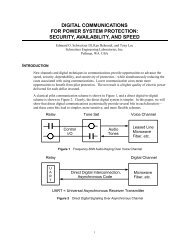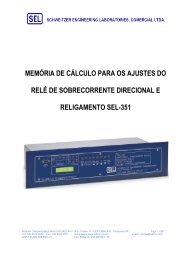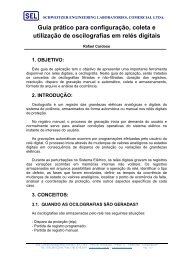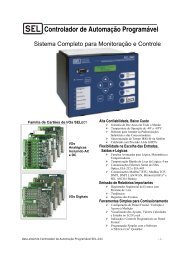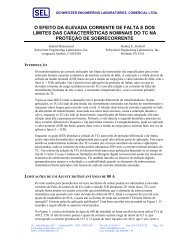Journal of Reliable Power - SEL
Journal of Reliable Power - SEL
Journal of Reliable Power - SEL
Create successful ePaper yourself
Turn your PDF publications into a flip-book with our unique Google optimized e-Paper software.
1<br />
Lessons Learned Analyzing Transmission Faults<br />
David Costello, Schweitzer Engineering Laboratories, Inc.<br />
Abstract—Transmission line relays record interesting power<br />
system phenomena and misoperations due to a variety <strong>of</strong><br />
problems. By analyzing event records, some common setting<br />
mistakes and misapplications have become evident. Setting and<br />
testing recommendations can be made to avoid these problems.<br />
In the interest <strong>of</strong> reducing transmission line relay misoperations,<br />
this technical paper shares practical lessons learned through<br />
experience analyzing transmission line relay event reports.<br />
I. FAULT LOCATION ERROR<br />
In December 2006, a single-line-to-ground fault occurred<br />
on a two-terminal 69 kV transmission line. The distance relay<br />
at the local terminal produced a fault location estimate, trip<br />
targets, and an event report. The actual fault location was<br />
found to be 3.6 miles from the local terminal, but the relay<br />
reported 7.31 miles. In addition, the relay targets included<br />
Zone 1 and time indication, which is contradictory because<br />
Zone 1 elements were set with no intentional time delay.<br />
Event data from the local relay are shown in Fig. 1.<br />
Ground current (3I0) reached a maximum magnitude <strong>of</strong> 3600<br />
amperes. The actual fault location was validated using this<br />
information and an ASPEN OneLiner power system model. In<br />
OneLiner, a line-to-ground fault was simulated and slid along<br />
the line until the 3I0 current matched the maximum value<br />
from the event data. The estimated location <strong>of</strong> this simulated<br />
fault matched the actual fault location from the field.<br />
IA IB IC IGMag<br />
VA(kV) VB(kV) VC(kV) VB(kV)Mag<br />
Digitals<br />
2500<br />
0<br />
-2500<br />
50<br />
25<br />
0<br />
-25<br />
-50<br />
Fig. 1.<br />
52A<br />
TRIP<br />
67G1<br />
51G<br />
IA IB IC IGMag<br />
VA(kV) VB(kV) VC(kV) VB(kV)Mag<br />
6.75 cycles<br />
0 1 2 3 4 5 6 7 8 9 10<br />
Cycles<br />
Event Data From 69 kV Transmission Line Relay<br />
The event data capture was triggered at Cycle 2 by an<br />
inverse-time ground overcurrent element (51G). The 3I0<br />
current is small (200 amperes 3I0) at the fault inception<br />
because <strong>of</strong> arcing or fault impedance. In the fifth cycle, the<br />
ground fault evolves into a bolted fault (3600 amperes 3I0).<br />
The instantaneous ground overcurrent element (67G1) asserts<br />
and calls for a trip, and the breaker opens 3 cycles later.<br />
An event record typically contains prefault, fault, and<br />
postfault data. After the event record is stored, the relay<br />
executes the fault location algorithm. This algorithm must first<br />
extract voltage and current phasor information from a point<br />
within the event data. What is the best point in the event data<br />
to choose<br />
A typical fault location algorithm will determine the<br />
contiguous fault data, which are defined by the window <strong>of</strong><br />
time in which the element that triggered the event remains<br />
asserted. In Fig. 1, this window <strong>of</strong> time is 6.75 cycles long.<br />
The algorithm assumes that the contiguous data midpoint is a<br />
reasonably stable point at which to estimate the fault location.<br />
In this case, the fault data midpoint is just before the ground<br />
current magnitude increased to a larger value. The dramatic<br />
evolution <strong>of</strong> the fault and its unlikely timing led to the fault<br />
location error.<br />
An <strong>of</strong>fline analysis <strong>of</strong> this event is required so one can<br />
manipulate where in the event data the fault algorithm extracts<br />
voltages and currents. In Fig. 2, a relay fault location algorithm<br />
is plotted using a MathCad simulation. At Cycle 6.75,<br />
the midpoint <strong>of</strong> the bolted fault data, the fault location<br />
estimate matches the actual fault location.<br />
m<br />
15<br />
10<br />
5<br />
Fig. 2.<br />
0<br />
0 1 2 3 4 5 6 7 8 9 10<br />
Cycles<br />
Fault Location MathCad Simulation<br />
We must now explain why a trip caused by an<br />
instantaneous ground element produced a time target. How<br />
fast is an instantaneous trip versus a time-delayed trip In this<br />
particular relay, the time target asserts when elements selected<br />
by the user have been asserted for longer than 3 cycles before<br />
a trip occurs. If the trip occurs before 3 cycles, we label the<br />
trip as instantaneous [1]. The same element that triggered the<br />
event data capture, 51G, was also set to signify that a fault is<br />
present. The dramatic evolution <strong>of</strong> the fault and its unlikely<br />
timing led to the confusing targets as well.<br />
Single-ended fault location estimates from relays are<br />
accurate in most cases. Offline tools, such as MathCad<br />
worksheets, can improve fault location accuracy for challenging<br />
cases. These tools <strong>of</strong>fer the ability to vary the location at<br />
which the fault location estimate is calculated and can include<br />
data from both ends <strong>of</strong> the transmission line for even better<br />
results [2].<br />
52 | <strong>Journal</strong> <strong>of</strong> <strong>Reliable</strong> <strong>Power</strong>



